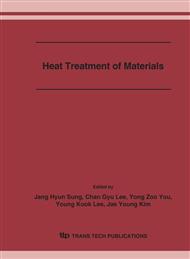p.381
p.387
p.393
p.399
p.405
p.415
p.419
p.425
p.431
Influences of Elastic Stress and Interfacial Kinetic Barrier on Phase Evolution Paths of Thin-Film Diffusion Couples
Abstract:
An explicit, finite difference scheme was used to examine the effects of coherency stresses and interface kinetic barriers on the phase evolution of a binary, thin-film diffusion couple. Thin-films, initially consisting of alternating layers of two terminal phases, α and γ, were held at a temperature at which the formation of an intermediate phase, β, at α/γ interface was thermodynamically probable. When either the coherency stresses or interface kinetic barriers are present, the interfacial compositions become time-dependent and, thus, the formation of the thermodynamically stable β phase can be kinetically prohibited at the early stage of the evolution. Even if the initial α/γ thin-films have the same overall composition, the coherency constraint can result in different final equilibrium states depending on either the initial compositions of the α and γ phases or the relative magnitudes of the interfacial kinetic barriers. When both the coherency constraint and interfacial kinetic barriers are present, an intermediate phase can repeatedly form and disappear during the evolution.
Info:
Periodical:
Pages:
405-412
Citation:
Online since:
December 2006
Authors:
Price:
Сopyright:
© 2006 Trans Tech Publications Ltd. All Rights Reserved
Share:
Citation:


